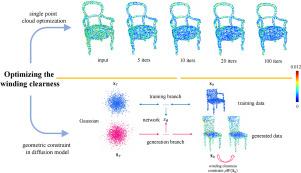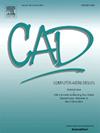可微点云优化的绕线清晰度
IF 3.1
3区 计算机科学
Q2 COMPUTER SCIENCE, SOFTWARE ENGINEERING
引用次数: 0
摘要
我们建议通过缠绕度来探索原始点云的性质,这是我们首先引入的一个概念,用于测量由点云的圈数场表示的内部/外部关系的清晰度。在几何建模中,圈数是区分给定表面∂Ω的内部和外部的强大工具,并且它之前已用于点法线定向和表面重建。本文提出了一种基于缠绕度的点云质量评价与优化方法。我们观察到,噪声较小的点云通常表现出更好的缠绕清晰度。因此,我们提出了一个目标函数来量化绕线清晰度的误差,仅利用点云的坐标。此外,我们还证明了绕线清晰度误差是可微的,可以作为点云处理中的损失函数。我们从两个方面提出了这一观察:(1)我们通过对单个点云的损失函数进行反向传播来更新点的坐标,从而在不涉及神经网络的情况下实现整体改进。(2)在基于扩散的三维生成模型中,将绕线清晰度作为几何约束,更新网络参数,生成噪声更小的点云。实验结果表明,优化缠绕度对提高点云质量是有效的。值得注意的是,我们的方法在处理具有薄结构的噪声点云方面表现出优异的性能,突出了由圈数支持的全局视角的好处。源代码可从https://github.com/Submanifold/WindingClearness获得。本文章由计算机程序翻译,如有差异,请以英文原文为准。

Winding clearness for differentiable point cloud optimization
We propose to explore the properties of raw point clouds through the winding clearness, a concept we first introduce for measuring the clarity of the interior/exterior relationships represented by the winding number field of the point cloud. In geometric modeling, the winding number is a powerful tool for distinguishing the interior and exterior of a given surface , and it has been previously used for point normal orientation and surface reconstruction. In this work, we introduce a novel approach to evaluate and optimize the quality of point clouds based on the winding clearness. We observe that point clouds with less noise generally exhibit better winding clearness. Accordingly, we propose an objective function that quantifies the error in winding clearness, solely utilizing the coordinates of the point clouds. Moreover, we demonstrate that the winding clearness error is differentiable and can serve as a loss function in point cloud processing. We present this observation from two aspects: (1) We update the coordinates of the points by back-propagating the loss function for individual point clouds, resulting in an overall improvement without involving a neural network. (2) We incorporate winding clearness as a geometric constraint in the diffusion-based 3D generative model and update the network parameters to generate point clouds with less noise. Experimental results demonstrate the effectiveness of optimizing the winding clearness in enhancing the point cloud quality. Notably, our method exhibits superior performance in handling noisy point clouds with thin structures, highlighting the benefits of the global perspective enabled by the winding number. The source code is available at https://github.com/Submanifold/WindingClearness.
求助全文
通过发布文献求助,成功后即可免费获取论文全文。
去求助
来源期刊

Computer-Aided Design
工程技术-计算机:软件工程
CiteScore
5.50
自引率
4.70%
发文量
117
审稿时长
4.2 months
期刊介绍:
Computer-Aided Design is a leading international journal that provides academia and industry with key papers on research and developments in the application of computers to design.
Computer-Aided Design invites papers reporting new research, as well as novel or particularly significant applications, within a wide range of topics, spanning all stages of design process from concept creation to manufacture and beyond.
 求助内容:
求助内容: 应助结果提醒方式:
应助结果提醒方式:


